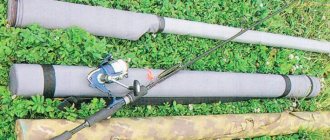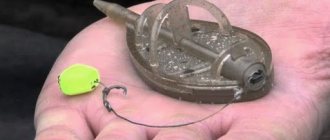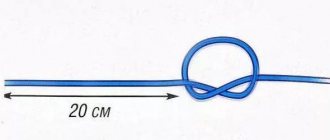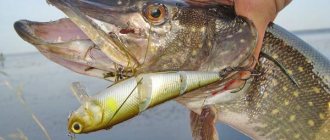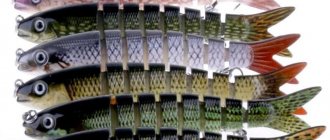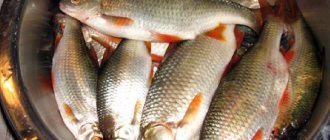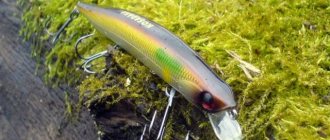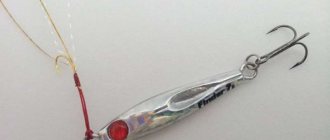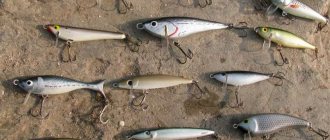Box for wobblers
A box for wobblers and spinners is an indispensable attribute of any self-respecting fisherman.
This fishing box is used to accurately store and easily transport spoons, wobblers and other fish baits. Using this box, the fisherman sorts the baits according to their size and method of use, which greatly facilitates the fishing process and speeds up the search for the spinners and wobblers needed at the moment. For avid fishermen, this box is already a huge, heavy box that takes up a lot of space (usually in a garage or storage room). Before fishing, the necessary baits are moved from the box into smaller boxes that correspond to the time of year, weather conditions at the moment and the type of fish that will be “hunted”.
Types of boxes for wobblers
Fishing boxes for baits are:
- universal;
- specialized.
The latter option is sold by shops for anglers and is produced exclusively for storing spinners and wobblers. They may differ in design, number and volume of compartments and other configurations (for example, with removable partitions or double-sided boxes), which take into account the characteristics of a particular type and method of fishing. These boxes are made from high-quality special plastic, which is resistant to mechanical damage and does not react with the material of modern baits.
Not all fishermen have the financial means to spend money on branded boxes. Therefore, they adapt construction and carpentry boxes, food containers, first aid kits and other boxes for them, modifying them to suit their own needs. This approach also has a number of advantages: you don’t need to spend extra money, you can personally modify it and adapt it to your own needs; many of these boxes, especially construction and food boxes, are made of high-quality plastic, resistant to external influences, and designed for use in extreme conditions.
Both branded boxes and homemade boxes are actively used by fishermen; which one to choose depends solely on the wishes of the fishing enthusiast himself.
Specialized box for wobblers
The assortment of this type of box is so large that even fishermen with many years of experience get lost among the options offered.
If you have many types of baits, then large, spacious boxes are ideal for storing them. Such boxes usually have several levels, many pull-out pockets, and there are also models that, like a nesting doll, include smaller boxes.
Large boxes are usually taken by anglers who prefer to troll from a boat. Once installed on board the boat, the desired bait will always be at hand.
Matryoshka boxes are suitable for permanent storage of baits in one place and are not very convenient for transportation. Before fishing, simply select a smaller box with the necessary wobblers and remove it from the main box.
Bait storage
Wobblers and spoons have sharp hooks that can damage other baits. To ensure that active dangerous parts do not harm the bait, wobblers must be placed one in each compartment of the box. It is important that the compartment is slightly larger than the wobbler itself. A double-sided box is often sold on the fishing equipment market; this option is very convenient and compact, which is why we especially love it among spinning anglers.
Homemade bait box
Many people wonder how to make a box for wobblers with their own hands.
For these purposes, you can adapt and remake an ordinary lunch box or food container:
- We select a container of the required size; it is important that its lid does not dangle, but closes tightly;
- The inner part is framed with foam rubber, which will dampen noise during transportation, and it is also very convenient to attach wobblers to it.
Such a budget box for wobblers will save money and give the fisherman the opportunity to design a box to his own taste.
Let's sum it up
Any option is good, and each angler makes a choice in relation to baits and their boxes from his own experience.
Specialized boxes for baits
Today, boxes for wobblers and spinners are produced in a wide range. The choice is so multifaceted that even experienced spinning anglers get confused when buying a container for specific baits. Beginners in fishing have a hard time with this question. Often meaningless acquisitions are made, which then gather dust and lie idle.
To store a large number of baits, it is advisable to use large, capacious boxes. These are multi-level organizers that have several pull-out shelves where it is convenient to place wobblers, silicone and spinners. They can also be equipped with various boxes and smaller boxes.
Large boxes are loved by trolling enthusiasts who own a large number of wobblers. Such systems are conveniently located in the boat; all the necessary baits, fishing accessories and tools are at hand. You don’t need to look for them in your backpack; they are not scattered throughout the boat.
Multifunctional boxes are suitable for stationary storage of spinning baits. It is not necessary to always drag it with you to the pond. Before fishing, you can select the necessary models and put them into small boxes and boxes.
Large containers are not suitable for running fishing from the shore. To do this, they use small boxes for spinners and wobblers, in which catchable bait models are placed, necessary for fishing a specific predator in the given conditions.
Fishing vests are used for running fishing. They have many pockets where you can place boxes of bait and save yourself from carrying a backpack or an uncomfortable bag. This equipment is especially popular when fishing in the wade.
Storing wobblers
Anglers often have a question: how to store wobblers in a box so that they do not get tangled and do not scratch the coating with hooks? For this purpose, specialized plastic boxes with removable partitions are used. They allow you to customize the box configuration yourself, choosing the required number of compartments and their size.
Wobblers should be placed one at a time in the compartments. The dimensions of the cell should not greatly exceed the dimensions of the hard plastic bait. This allows:
- Avoid contact of baits with each other.
- Minimize the movement of the wobbler inside the compartment.
To optimize space, manufacturers have developed a double-sided box for wobblers. Its main advantage is its compactness and at the same time spaciousness. This option is popular among spinners.
For ultralight baits
Ultralight spinning rods use miniature baits that do not require the fisherman to have large capacious boxes. For wobblers and silicone, it is customary to use small plastic boxes; they easily fit into a jacket or vest pocket. They are compact and do not burden the fishing process. If necessary, they can always be transferred to the backpack compartment.
For microoscillators and small turntables, specialized cases are used. This original solution to spinning came from fly fishing and immediately gained popularity. In this case, a box for storing spinners is not needed, and the pencil case used is much more compact and ergonomic.
Lure box: whim or necessity?
Where and in what to store spinners is a purely personal matter; for some it is easier to find the right thing among all the chaotically located variety in a fishing box, but for others, order is needed in everything.
- Varieties
- Required parameters
- With your own hands
Of course, a box for spinners is more of a necessity than a whim. Useful and necessary qualities of a container for storing artificial baits include:
- ease of transportation and operation;
- protection of attachments (and sometimes very expensive ones) from various types of damage (breakage, scratching, etc.);
- Minimum waste of time when searching for the right product.
Accessories for fishing fans
In order not to lose and preserve the bait, you will need to make a wallet for the spinners yourself or buy it. It will be possible to safely transport sharp hooks. A bag case for spinners is a convenient accessory. This product can be of various sizes: 17x13 cm, 7x10 cm, 16x12x4.5 cm. Any bag for spinners can be equipped with a zipper, which will provide instant access to baits. Compact products can contain several pages inside where all the bait can be placed. The form factor of this wallet is convenient. The bag and case for the spinners can even fit in a men’s clothing pocket.
The online store has many interesting products. Any cover for spinners is universal.
Here are some tips to help you choose a worthy purchase from a large number of products:
- First you need to decide on the size that will be convenient in your case.
- For some men, the color of the product is important, so manufacturers offer different shades.
- Availability of waterproof material. This is important because fishermen often have to come into contact with water.
- The presence of a solid partition inside, which will provide protection for spinners and wobblers.
This case for spinners is not too expensive. The cost largely depends on the brand and quality.
Varieties
The most budget option is all kinds of containers that are often used at home (construction economizers, car and home first aid kits, food containers, etc.).
Construction boxes are most often used, given their diversity not only in appearance and internal design, but also in size, which sometimes plays a decisive role in the choice of a particular accessory. Special-purpose fishing boxes are in quite high demand among consumers of such products. Their dimensions are maximally adapted to certain sizes of manufactured baits. Such containers fit perfectly into the pockets of equipment and fishing backpacks. Although their cost is much higher than the same construction suitcases, the comfort is worth it.
Required parameters
When choosing a high-quality box for spinners, first of all you need to focus on the following characteristics:
- Container size - given the constant updating of baits, it is more advisable to purchase a fishing box, if not the largest, then at least a medium one.
- The presence of internal compartments - the ideal option is a large box with many internal compartments and mobile partitions.
- The presence of handles and straps for transportation is such a necessary accessory that allows you to easily carry the box during frequent movements along the shore of the reservoir.
With your own hands
You can make a box for storing spinners yourself, from scrap materials. For this you will need:
- a transparent plastic food container with a tight-fitting lid;
- foam strip for edging;
- self-tapping screws for fixing the edging.
Inside the plastic container around the entire perimeter there is a edging (foam strip 1x1 cm). To increase the versatility of a homemade product, you can additionally fix a similar strip in the middle part (across) of the container. Lures in such a box cling to a strip of foam using hooks. It is better to purchase a container depending on the size of the bait. To ensure that the strips are held securely, they can be secured through the walls of the container with small self-tapping screws. For convenient transportation, the box is equipped with handles.
For the second option you will need:
- 2 organizers for hardware;
- adhesive-based sealant (for insulating windows);
- a piece of cuff elastic;
- automotive double-sided tape;
- scissors.
First you need to cut the seal to the size of the existing cells. Next, you need to remove the protective film from the strips and glue them to the bottom of the cell. Double-sided tape should be attached to the bottom of the organizer. Then you need to remove the protective layer and glue the elastic band to the bottom of the same organizer. After this, you need to remove the protective layer from the second organizer, and then connect (glue) them together with the bottom. The box for storing spinners and other baits is ready for use.
Thanks to the elastic band, it can be attached to both the hip and the belt. If you use a belt or something with a clasp instead of an elastic band, then carrying a bait box will become even more convenient and reliable.
A box for storing spinners is a very convenient thing, which makes it possible to reduce the time spent searching for the desired bait and ensures the safety of the contents.
Video about bait storage boxes:
Video about the “mysterious” box:
DIY box for lures and hooks with a magnetic lock
Hello, dear readers and DIYers! Surely there will be fishing lovers among you. And this difficult task requires many different lures and hooks. In this article, the author of the YouTube channel “Third Coast Craftsman” will tell you how he made a beautiful and practical box for storing them.
The master will make this homemade product almost entirely using hand tools.
Materials. — Pallet board, ebony ebony — Neodymium magnets — Sandpaper — Furniture hinge — Wood screws — Linseed oil — PVA glue, two-component epoxy glue.
Tools used by the author. — Plane, jointer, chisels, rasp, miter box — Hand plane — milling cutter (you can read about its manufacture in this article) — Clamps — Screwdriver — Rubber spatula, rags — Screwdrivers, square, ruler, pencil, marker. Manufacturing process. The author found some very remarkable pallet boards in his lumber yard, presumably made of maple or balsa wood. Their peculiarity was thin dark fibers that lay in veins in the structure of the wood and create an unusual wood pattern.
Sometimes the material itself inspires the master to create a “masterpiece”... This is what happened in this case. The idea was born to make a neat box for fishing hooks from this seemingly unsightly old wood.
First of all, the master cuts the pallet boards to the length of the future product, using a kind of miter box
In the same way, using a plane, he removes the weathered layer of wood from the front and back sides of the boards, planing their surfaces and exposing the unusual wood pattern.
Now the bottom needs to be edged. For this purpose, the author selects Coromandel black (ebony) wood for contrast. The master cuts the edge itself on a circular saw, making 45-degree bevels at the corners.
The dark side sits on the glue and is fastened with a rubber band. Excess glue is carefully removed with a spatula.
The next stage is the hinges, which should hold both flaps of the box together. It turned out to be not so easy to choose hinges of suitable sizes, because the box is quite small, and the cutouts for the hinges are even smaller. The author chose piano hinges. The only pity is that their full turn was not 180, but 90 degrees.
The author carefully measures the location of the loop, achieving perfect symmetry. Then he marks the future holes and the perimeter of the loop.
Now you need to drill blind pilot holes for the screws.
Using a hand plane - a milling cutter and a chisel, a recess is cut out for the loop.
The magnets are attached with two-component epoxy adhesive. Here it is important to maintain the polarity of the magnets in the lid and bottom, otherwise they will repel instead of closing!
And this is what the finished box looks like. Well, what avid fisherman would refuse such a gift?
Source
Become the author of the site, publish your own articles, descriptions of homemade products and pay for the text. Read more here.
Where is it convenient to store wobblers? Convenient boxes for wobblers and baits
I think every fan of spinning fishing will definitely think about where it is more convenient to store wobblers, twisters and other fishing utensils. In fact, there are a lot of storage methods, you can buy tool boxes and simply store wobblers in compartments, but this method is not very convenient, because the hooks get tangled and when you get the right wobbler, you end up with several at once.
However, there are also special fishing boxes that can be divided into two types, these are boxes with adjustable partitions and double-sided boxes with triangular compartments, each of these types of boxes is convenient in its own way.
Homemade bait box
A DIY tackle box can be made from a food container. For this you will need:
- Food box of the required size. Take a model with a tight-fitting lid.
- A strip of foam plastic measuring 1x1 cm for organizing the edging.
- Small screws to secure the edging.
The edging is attached inside the box. Lures are attached to the foam with hooks. This DIY wobbler box has a minimal cost and is easy to make. Its disadvantage is that the edging is short-lived and must be renewed periodically.
To store micro-oscillators and ultra-light turntables, you can use a banal school pencil case with a zipper. To do this, foam rubber plates are placed inside, to which baits will cling with tees. This simple DIY spinner box is original and simple, with virtually no cost.
Convenient storage box for 14 wobblers
The box is made of fairly thick transparent plastic. On the side there is a flexible rubber handle, which at rest is in a straightened state and pressed against the end. It is easy to pry off with your fingers and, in my opinion, is intended rather only for removing the box from the bag. If you use a handle to carry the box, you should take into account that the rubber strap is very securely fixed only in extreme positions, but on average it jumps off the plastic guides quite freely at a certain bending angle. The handle is quick-release, some people need it, and some don’t. Therefore, if you really need to, you grab it with three or four fingers and carry it without swinging your hand too widely.
The box is double-sided and has overall dimensions of 273x167x45. The covers on each side are secured to reliable hinges that do not jam during operation and are held closed by a pair of convenient latches. What’s nice is that the box is “tightly built”, there is no sign of any wobbling or looseness of the lids when closed. Each side has seven full compartments and one narrow one. This means that a total of at least 14 wobblers with a maximum length equal to the internal size of 146 mm can be placed in the box. Wobblers of shorter length are placed “jack” or one after the other. Only something with a very skinny body will fit into a narrow cell. Personally, string leashes have taken root there - both for them and for me, it’s very convenient.
Types of cuts
Hooks are divided into several main types, which are used in different cases, depending on the location of the hook of the artificial bait.
Main types:
- Coastal.
- Boat
- Universal.
Coastal
- A loop. In some cases, a fishing line that is shaped like a loop can help with hooking. Using the force of the current, it allows you to hook the wobbler and release it from underwater obstacles. At the same time, you should not make sharp jerks with the rod, as the bait may catch “tightly” on a snag or root.
- "Cat". This species is the most ancient and popular among fishermen. It is made from a piece of thick wire and connected to a strong and long cord. Success in unhooking your favorite bait depends on how accurately the fisherman casts the “cat”. Casting is done manually.
- Wire loop. The entire structure consists of a wire loop and a long stick. The fishing line from the tackle must be placed in this loop and the stick with the loop is directed towards the bait, freeing it.
- Another simple release is the “floating ring” design. It can be made from available materials, for example, from a willow branch or other bendable wood. A branch 50-70 cm long and cleared of bark is rolled into a ring, the joint is connected with fishing line or rope. The fishing line from the hooked tackle is threaded inside the resulting cut and the “floating ring” is cast further downstream from the bait. When the ring begins to float near the place of the hook, you should make several sharp gusts with the rod, which will lead to the release of the bait.
Boat
When releasing the bait from the boat, the fisherman has some advantage, since by boat he can swim closer to the place of the “action”.
If the wobbler gets caught in shallow water, you can free it by hand. When getting caught in deeper parts of a river or pond, a structure made of a long stick with a wire loop will help.
Make it a rule, on every fishing trip, the first thing you do is...
- "Cat". This design is a ring made of lead, the weight of which reaches 200 g. Large tees are connected to the ring with wire loops. While lowering the “cat” along the fishing line to the hooked wobbler, the tees catch it and release the artificial bait with the force of a jerk.
- Bumper. Here a weighting agent made of lead or brass weighing from 50 to 200 g is used. A wire loop is inserted into the hole in the weight. The line from the tackle is passed through the loop and the release is immersed in the water. The bait is released when the bumper is sharply lowered to the bottom of the reservoir.
- Trap. It is the most complex in its design, which consists of a drop-shaped load. A wire ring is attached to its lower part, on which a spring frame in the shape of the letter “M” rests. When it comes into contact with the wobbler, the frame opens, the bait passes through the ring and rests against the tee. Then, with a strong jerk, the wobbler is released from the hook.
Universal
Can be used when releasing bait, both from a boat and from the shore. Release using the universal type of release is carried out as follows:
- The wire ring is connected to a strong, long cord. Tees are attached to the ring.
- The fishing line from the tackle is passed through the wire loop.
- The release is immersed in the water along the working thread to the bottom of the reservoir.
- The release of the bait can occur through the tees hooking the bait itself or the snag on which it is caught.
- A few sharp jerks with the cord will help release the wobbler.
Boxes for wobblers with adjustable partitions
Boxes for wobblers of this type are also double-sided. In water boxes it is very convenient to combine the storage of large 130 wobblers and small crankbaits or spinners; a large number of compartments allows you to conveniently place the entire set of wobblers. However, you should not put more than 2 wobblers in one compartment at a time, otherwise you will spend 10 minutes unraveling the garland of wobblers, and the coating of the wobblers peels off much faster during such storage.
In my opinion, such boxes are more convenient if their height is no more than 3-4 cm; you can usually put 5-6 of these boxes in a bag easily, and this is very convenient.
Special boxes for storing wobblers
Vertical storage of wobblers is also a convenient option, especially for fishing from a boat. However, I believe that the big disadvantage of such boxes is the poor visibility of the wobblers that are located in the center of the box, it’s convenient to remove them, but sometimes it’s problematic to remember where which one is, and you have to look for the right one for a long time.
In transparent boxes of the classic type, you can immediately see where each wobbler is, but the box certainly holds much more baits. Another important disadvantage of such boxes is the price; unfortunately, it is quite high, so if you need just such a box, you can make it yourself from a container and plastic partitions.
How to do it yourself
You can also make containers for storing the spinner with your own hands. A homemade box is remarkable in that it can be made to the desired size and with a sufficient number of compartments. A box of spoons is made from improvised materials.
A homemade container for storing spinners is made from the following materials:
- a transparent plastic container for storing food;
- foam strips;
- self-tapping screws
Place a edging - a foam strip - inside the container. Size approximately 1*1 cm. The bait will cling using hooks. It will be good if the container with baits is the same size.
For versatility of the product, you can place 1 more strip across the container.
Secure the strips with self-tapping screws. To make the box easier to carry, make handles.
There is another option for making a homemade container. You will need an organizer for hardware, a sealant with an adhesive backing, a piece of rubber, and double-sided tape. The sealant is cut to fit the cell size. The protective film is glued to the bottom of the cell.
Attach tape to the bottom. After removing the protective layer, attach the rubber band to the bottom of the container. Having removed this film from the 2nd organizer, connect them at the bottom. The box is ready for use. It is easy to carry the spinner in it, because thanks to the elastic band, the container can be attached to both the belt and the hips. If you replace the elastic band with a belt, then moving the boxes will become easier.
Containers for storing and carrying spinners are an indispensable item in a fisherman’s arsenal. With them, the time spent searching for the necessary bait will be reduced, and the contents will be reliably protected. You don’t have to carry boxes with you every time you go fishing, but select only the necessary lures. They are easy to use and do not require large financial outlays. The container can be made according to your own wishes.
Boxes for tools and hardware are also an option for storing wobblers
However, it is not necessary to buy boxes only in fishing stores; there are plenty of options in construction supermarkets. For example, a good option is a double-sided suitcase for hardware with adjustable partitions; you can take a larger or smaller option. In such boxes it is convenient to store large wobblers of 110 and 130 mm in size, as well as their deep-sea versions.
Such options also have some disadvantages; as a rule, many such suitcases have a handle that takes up additional space. And also building boxes are usually black and opaque in color and because of this the contents of the cells are difficult to see.
Universal boxes for small items
There are also universal boxes for small items, in which you can also store large wobblers; such boxes are usually quite cheap, but not all boxes are equally good for storing wobblers. It is best to take boxes with hinges on the lid, otherwise very often the lid simply breaks off due to frequent openings and there is a risk of all the wobblers spilling out at the most inopportune moment.
Read other articles, reviews and testimonials:
- Review of the Favorite Professional spinning rod. Reviews from fishermen about the Favorit Professional spinning rod
Favorite Professional spinning rods have high rigidity, lightness, sensitivity and fast action. If required high enough.
“>Review of the Favorite Professional spinning rod. Reviews from fishermen about the Favorit Professional spinning rod Kastmaster spinners. How to fish correctly with castmaster?
Among the countless number of diverse artificial baits, the Kastmaster spinner stands apart, thanks to its unique design and...
“>Kastmaster spinners. How to fish correctly with castmaster? Kosadaka Voyager 4Pro - Review of travel spinning rod for travel
Kosadaka Voyager 4Pro spinning rods are extremely lightweight, durable and reliable plug rods made of carbon. The main feature of this line of rods.
“>Kosadaka Voyager 4Pro - Review of travel spinning rod for travel Review of Hearty Rise Halcyon spinning rod. Reviews from fishermen about the spinning rod Herty Rise Halcyon
Hearty Rise experts have developed a line of Halcyon spinning rods specifically for light fishing. Experienced anglers will appreciate the sensitivity of the blank.
“>Review of the Hearty Rise Halcyon spinning rod. Reviews from fishermen about the spinning rod Herty Rise Halcyon Review of the travel spinning rod Norstream Flagman T. Reviews from fishermen about the spinning rod Nordstream Flagman T
Norstream Flagman-T spinning rods are a series of inexpensive compact rods. The letter "T" in the name stands for "Travel", which is translated from English as.

